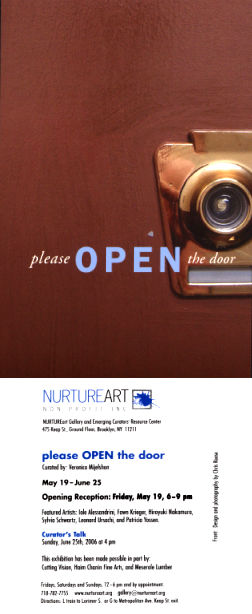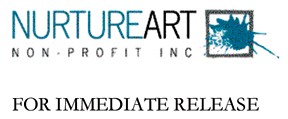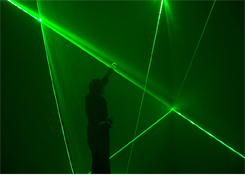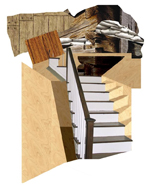

NURTUREart
Non-Profit, Inc. presents
PLEASE OPEN THE DOOR
May 19 – June 25, 2006
Opening reception: Friday, May 19, 2006, 6 – 9 p.m.
Curator's talk: Sunday, June 25, 2006, 4:00 p.m.
April 26, 2006, Williamsburg, Brooklyn, NY – PLEASE OPEN THE DOOR
is a group exhibition that comprises site specific works by six visual
artists working in sculpture, installation, light, and painting, curated
by Veronica Mijelshon. The exhibition explores the boundaries between
private and public, inner and outer, physical and mental spaces. Each
artist was designated a booth with a door measuring 3 _ (W) x 6 _ (L)
x 7 _ (H), built in-situ and asked to respond to that particular space.
Each booth presents the artist with a space of freedom to create a world.
In conjunction with the exhibition, NURTUREart presents a curator’s
talk on Sunday, June 25.
The artists featured in the exhibition are: Iole Alessandrini, Fawn
Krieger, Hiroyuki Nakamura, Sylvia Schwartz, Leonard Ursachi, and Patricia
Yossen.
Gaston Bachelard defines the concept of door, "How concrete everything
becomes in the world of the spirit when an object, a mere door, can
give us images of hesitation, temptation, desire, security, welcome
and respect". (Gaston Bachelard, The Poetics of Space, 1958) A
door usually delimits spaces. It is one of those universal symbols that
separate the public from the private sphere, as a fence or a wall. But
unlike those, a door opens up the possibility, the possibility of transgressing
the barrier.
As in Bachelard’s statement, each artist transforms a uniform
space into a universe that responds to his or her inner vision. The
same is true for the viewer who will have a unique interpretation and
reaction to the work; the viewer, for instance, can choose to open the
door, remain inside alone, simply peek in, or never experience the piece.
We can compare the booths to human beings: from the same basic elements
arise unique and personal minds, dreams, ambitions, expectations, and
reactions. The exhibition underscores and makes tangible the phenomenon
of art as both an inner, private experience, and a public, collective
one. Art is as much an individual creation as the result of the social
context in which it is created.
Through manipulation of light, digital media and physical space, Iole
Alessandrini designs and builds ephemeral, controlled environments
for people to enter and explore. Light is energy: waves and particles
of infinitesimal dimensions that are made visible by boundaries. Architecture
is change: a powerful and meaningful physical symbol that redefines
space and creates new functions. Physical space in its states of transformation
solicits emotional feelings and brings back memories. Light, being a
remote projection from a time of which we have no memory, alters these
feelings and stirs our emotions and ideas.
Two artists in the exhibition create sculpture and installations with
architectural references. Fawn Krieger borrows the vernacular
of domestic American architecture to deconstruct and reestablish traditional
notions of home, inviting viewers to become active participants within
her constructions. Krieger’s structures are offerings of protection
and comfort as well as revelation and exposure. In return, Krieger builds
a staircase inside and places a ladder outside the booth. Combining
tangible and metaphorical elements of ascension and descension, the
territory between basement and attic is occupied by the viewer who climbs
up and down her installation, bypassing imposed points of entry, and
positioning the body itself as both home and threshold. return is part
tree-house, part fallout shelter, part Guantanamo Bay surveillance terminal,
and part Aliyah. Leonard Ursachi uses architecture as a metaphor
for systems that enclose and exclude, protect and reject. He is interested
in the impact of structures – whether material, theoretical, social,
or political – on individuals and communities. To enter and comprehend
Slice, viewers must squeeze on either side of a white picket fence that
divides the space in two which has symbols of privilege and comfort.
A gold chair protrudes from the walls, two 19th century portraits, mirrored
walls; but people can’t sit on the chairs and the portraits have
been slashed at the mouth. In Slice, Ursachi blurs the boundaries between
political/personal, public/private, comfort/pain. yours/mine. He dedicates
this piece to Nikolai G. Tolstykh (aka Tolstich), a soviet intellectual
and dissident who emigrated to NY. Mr. Tolstykh became homeless and
disappeared in 2000 after being charged by NYC police for “obstructing
a park bench” because he has his briefcase on it (1).
Sylvia Schwartz and Patricia Yossen refer to the idea
of overcrowding and congestion in urban spaces. Inspired strongly in
nature, Sylvia Schwartz sees her sculpture more like a collection of
evidence rather than a creation. For this exhibition, she overstuffs
her space with oversized plaster blades of grass. Floor, ceiling and
walls are seen as boundaries paralleling our own bodies; uprooted from
its environment, nature is brought indoors, reinterpreted and relocated
suggesting patterns of human migration. In her sculpture-plant, animal
and human forms are deliberately blurred. The variability of each blade
and their fluidity resemble our own state of constant transition, both
mental and physical. Patricia Yossen uses idealized human forms to awaken
strong and personal emotions in the spectator related to memory, distance
and identity. The artist is interested in how individual histories interweave
with a finite number of shared icons, themes and motifs to form a collective
consciousness in modern western society. Yossen proposes a “public”
idea from her most “private” inner space. Resembling New
Yorkers’ apartments, or perhaps a specific social circle, the
artist covers the walls with threatening-ironic-sarcastic smiling faces
made of beeswax. The ideas of oppression, collective anguish, and fear
are suggested in this piece, but the ultimate interpretation is left
open for the viewer once s/he is alone in the deep tunnel of heads reflected
infinite times and observing, accepting, rejecting, or criticizing the
visitor.
Hiroyuki Nakamura approaches the booth as a purely psychological
boundary, an imaginary place. He investigates how elements of popular
culture become part of our individual consciousness and are reinterpreted
from an individual perspective based on personal experiences. In this
piece, Nakamura inserts the image of himself as a cowboy in an imaginary
landscape. The cowboy embodies our nostalgia for the disappearing last
human frontier. Since most geographical boundaries have been explored,
the cowboy is left to delve into the infinite and unknown territory
of the self.
The curator invites you to Please open the door for a personal experience....
Veronica Mijelshon is NURTUREart’s Gallery Director and an independent
curator. She earned her Architectural degree from Universidad de Buenos
Aires, Argentina, where she was born. Veronica Mijelshon is currently
developing GACHU, a public art project for hospitalized children. She
wrote essays for various exhibitions catalogues such as Flight, an exhibition
in DUMBO and Un Espacio Libre, a public art project installed in Caguas,
PR. Veronica Mijelshon is also a special assistant to the Diane Arbus
Estate.
Please Open the Door was made possible in part by Meserole Lumber and
private donations.
To learn more about the Emerging Curators’ Program please check
www.nurtureart.org.
Directions:
NURTUREart Gallery and Emerging Curators’ Resource Center: 475
Keap Street in Williamsburg, Brooklyn. It is located near the intersection
of Union and Metropolitan Avenues, just steps from the L train Lorimer
Street station or the G train Metropolitan Avenue station. The gallery
is open to the public on Fridays, Saturdays, and Sundays from noon to
6 p.m., and by appointment: 718.782.7755.
NURTUREart is a New York State licensed, federally tax-exempt charitable
fine art services organization founded in 1997 by George J. Robinson
and run partially by volunteer professionals. Founded on the conviction
that success in the visual arts is the result of collaboration not exclusion,
NURTUREart is committed to nurturing emerging artists and curators through
exposure, enrichment and opportunity. NURTUREart has mounted numerous
exhibitions of its Registry Artists’ and Curators’ work,
and presented a wide variety of enrichment events and Muse Fuse gatherings
at its Williamsburg gallery and at host venues throughout the New York
Metropolitan Area. Visit www.nurtureart.org.
The NURTUREart Gallery & Emerging Curators’ Resource Center
is funded in part by the Milton and Sally Avery Arts Foundation, Inc.,
Brooklyn Arts Council, and Leibowitz Foundation. NURTUREart appreciates
their support.



Iole Alessandrini, Untitled, interactive sound and laser installation, Jack Straw New Media Gallery, 2004; Fawn Krieger, return, study, composite digital drawing, 2006; Patricia Yossen, sketch, 2006 (1) On park bench, another jolt in a bumpy life; moved along by the police, a soviet émigré vanishes, NY Times, March 26, 2000